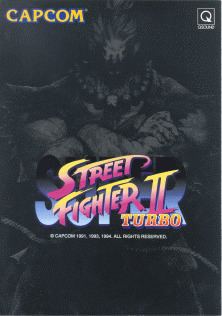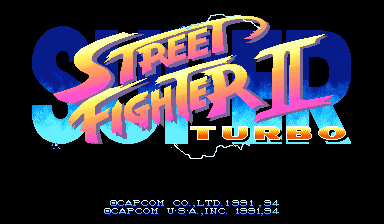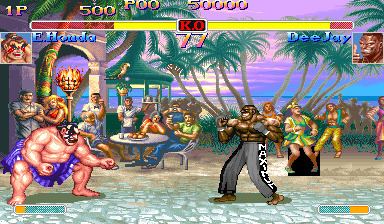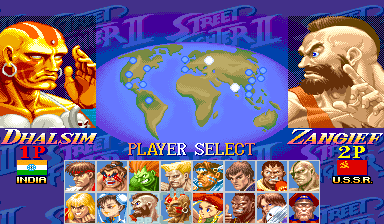Arcade system CPS-2 | Cabinet Upright Initial release date 23 February 1994 | |
 | ||
Composer(s) Isao AbeSyun Nishigaki Mode(s) Up to 2 players simultaneously Display Raster (horizontal),384×224 resolution,4096 colors on screen,16,777,216 color palette Similar Street Fighter games, Capcom games, Fighting games | ||
Super Street Fighter II Turbo, released in Japan as Super Street Fighter II X: Grand Master Challenge (スーパーストリートファイターII X -Grand Master Challenge-), is a competitive fighting game released for the arcades by Capcom in 1994. It is the fifth installment in the Street Fighter II sub-series of Street Fighter games, following Super Street Fighter II: The New Challengers. Like its predecessor, it ran on the CP System II hardware. It is commonly referred to as just Super Turbo, or ST for short.
Contents
- Gameplay
- Graphics and audio
- Game Speed
- Super MeterSuper Combos
- Air Juggles
- Throw Softening Throw Teching
- Alternate old versions
- Introduction of Akuma
- Home versions
- 3DO Interactive Multiplayer
- MS DOSAmiga
- PlayStation and Sega Saturn
- Dreamcast
- PlayStation 2 and Xbox
- Super Street Fighter II Turbo Revival
- Hyper Street Fighter II The Anniversary Edition
- Super Street Fighter II Turbo HD Remix
- Ultra Street Fighter II The Final Challengers
- Reception
- Competitive Play and History
- References

Super Turbo introduced several new gameplay mechanics not present in previous versions of Street Fighter II, including the addition of Super Combos and air combos. It also introduced the secret character Akuma, who would go on to become a recurring character in later Street Fighter installments and other Capcom fighting games.

Super Turbo was originally ported to the 3DO Interactive Multiplayer, followed by the PlayStation and Sega Saturn (under the title of Super Street Fighter II Turbo: The Ultimate Championship) as part of the Street Fighter Collection, and for the Dreamcast in Japan under the title of Super Street Fighter II X for Matching Service. A remake of the game was released for the PlayStation 3 and Xbox 360 titled Super Street Fighter II Turbo HD Remix.

While not as much of a commercial success as previous iterations of the game, the game was a critical darling and has had a huge impact on the competitive fighting game "e-sport" circuit. Super Street Fighter II Turbo is still played competitively over 20 years after its original release, and is the oldest fighting game that still has an active competitive tournament scene throughout the world.

Gameplay

Super Street Fighter II Turbo made the following changes and additions to the play mechanics inherited from Super Street Fighter II.
Graphics and audio

All of the stages, character portraits, and even the HUD featured new graphics. The original Unused opening sequence/Unused attract sequence which featured two generic characters fighting in front of a crowd was replaced by a new unused opening, featuring lead character Ryu launching a Hadoken projectile towards the screen. New animation frames were drawn for all the characters basic and special moves, and victory poses. For example, all four boss characters received new animation frames for basic attacks (Vega and Sagat did not have jumping punches in the previous games, while many of their standing and crouching attacks shared the same frames of animation), while Chun-Li received a new animation for her Kikoken projectile. The music and sound effects were also remade and a new announcer was introduced, who also recorded new voice samples for some of the characters (Ken, Guile, and Sagat).
Game Speed
A large criticism of Super Street Fighter II: The New Challengers was the slower game speed in comparison to the previous release: Street Fighter II: Hyper Fighting. Super Turbo was the first Street Fighter game released in arcades to feature an adjustable speed setting. The game speed can be adjusted through the system configuration by the game's operator or (if the speed setting is set to "Free Select") can be chosen by the player at the start of the game. The player has a choice between four speed settings.
Super Meter/Super Combos
Super Street Fighter II Turbo was the first game in the series to introduce Super Combos. These are usually enhanced versions of each character's special moves and are much more powerful than their normal counterparts. However, their use is limited by the new Super Combo Meter located at the bottom of the screen. This gauge is filled when the character connects attacks against the opponent, blocking or not. Special moves, such as fireballs, fill the meter upon execution, and fill the gauge faster. When the Super Combo gauge is full, the gauge will be replaced with the word "SUPER". The player will then be able to perform their character's Super Combo by inputting specific commands, which tend to be more complex than special move commands. Upon execution, the Super Combo gauge will reset back to zero. If an opponent is defeated with a Super Combo, the background will flash red and yellow. Any accumulation of Super Combo gauge does not carry over between rounds.
Air Juggles
Super Turbo also introduced the ability to perform a combo against an opponent in mid-air. Whereas previous versions of Street Fighter II feature a few techniques which would strike an opponent multiple times, Super Turbo was the first game in the series to feature an extensive air combo feature. Certain basic moves allow the player to strike an opponent more than once in the air and "juggle" them. These "juggling" moves can be connected into another juggling move or into a Super Combo.
Throw "Softening"/ Throw Teching
Super Turbo introduced the ability to "soften" an opponent's throw. If you are thrown by opponent, inputting your own throw command within a short time window will "soften" the throw, leading your character to land on their feet and take reduced damage. Holds, such as Blanka's headbite, Balrog's headbutt, and Ken's Knee Bash, cannot be softened, but damage can still be reduced by "mashing" (inputting multiple inputs on the joystick and buttons quickly). The "old" (aka "alternate" or "super") versions of each character cannot soften throws.
Alternate "old" versions
Super Street Fighter II Turbo allows players to play as versions of characters from the original Super Street Fighter II in addition to their regular counterparts in the game by inputting a code for each character. The character would play as they would in Super Street Fighter II, with subtle differences. For example, the alternate version of Sagat in Super Turbo can now cancel his light kick into any special move, whereas in Super Street Fighter II he couldn't.
This method has its strengths and weaknesses. The alternate characters cannot perform Super Combos, nor can they recover from an opponent's throw. On the other hand, some features are beneficial, such as the alternate versions of Ryu and Ken, who are invulnerable when they perform their Shoryuken and cannot be hit out of it (unlike their standard counterparts). All of the characters' original color palettes (i.e. Ryu's red headband and white gi, Chun-Li's blue outfit, M. Bison's red uniform, etc.) are only worn by their alternate counterparts, whereas the standard versions use a different default palette.
Introduction of Akuma
Super Street Fighter II Turbo saw the introduction of the series' first secret character, Akuma (Gouki in Japan). Should the player succeed in defeating all eight preliminary opponents, as well as Balrog, Vega, and Sagat without losing while getting at least 3 perfect rounds, Akuma will reveal himself. Once the player reaches M. Bison, at the start of the round Akuma will enter the stage and grab Bison, knocking him out with the Shun Goku Satsu technique, and challenge the player as an alternate final boss. There is no name under Akuma's health gauge, and the portrait next to it is completely black and has no power gauge. Akuma is a very difficult opponent, being able to move at very high speeds and deal large amounts of damage, as well as being immune to dizzying.
Akuma is playable as a secret character. He can be used by inputting a code at the player select screen. He is the most powerful character in the game by far and banned in all competitive tournaments of the game.
Home versions
While multiple iterations of Super Street Fighter II Turbo have been released or remixed for home consoles, none have been accepted for long term competitive play over the CPS2 arcade board. Most of the early console versions (3DO, PC, PS1/Saturn) suffered from inaccuracies due to the consoles power and shortcuts taken on animation and game size. The later console ports (PS2, Dreamcast) and HDRemix mostly suffer from small timing issues and glitches that wouldn't be noticed by casual players. Other versions of the game (Hyper SF2, HD Remix, SF Revival, Ultra SF2) are simply too different to be considered the same game. The current recommended console port is the Dreamcast, followed by playing HD:Remix in "classic" mode.
3DO Interactive Multiplayer
The 3DO port was released on November 13, 1994 in Japan, with subsequent releases in North America and Europe during the same year. While the graphics are more accurately reproduced compared to the previous console ports for 16-bit platforms, the game doesn't support parallax scrolling and is missing animations on characters. Also the Super versions of characters are not present. Although the loading times are considerably short by CD-ROM standards at the time, the game loads during battle when a player performs an elaborate move such as jumping (especially when both characters jump at the same time) and the controls are affected occasionally as well. The soundtrack features the same remixed music from the FM Towns version of Super Street Fighter II (with a few additional remixes specific to Super Turbo). This port also features "CPS1 Chains", a feature that only existed in the arcade versions up until Hyper Fighting.
MS-DOS/Amiga
The MS-DOS version, developed by Eurocom and published by GameTek, was released in May 1995 in North America and Europe. There are secret commands to use each character's original color scheme, as well as attacks that were removed from the 3DO version due to memory constraints. The option menus have custom settings (such as enabling and disabling parallax scrolling) that allows the game to be played with low hardware specifications. The biggest change is the game's resolution; the game is played with a resolution of 320x200 on AT/PC-compatible machines and, since the graphic data is ported straight from the arcade version, all of the characters appear large due to the narrow screen size. Because of this, the distance between both fighters at the beginning of a match is slightly narrower than in the arcade version. There were many glitches in the initial shipments of the DOS port, such as characters landing and recovering normally after landing from a jump if they're knocked out in mid-air with a basic attack. A patch file was distributed that corrected these glitches, which were later fixed in version 1.5 of the retail release. A patch file for version 1.6 was released as well. The music has been remixed as well, although the arrangements are different from the ones used in the 3DO soundtrack.
The Amiga port was also released by Gametek (and ported by Human Soft) in 1996, which is graphically very close to the original arcade version and features a remixed soundtrack, but suffers from jerky animation and other shortcomings when played on an unexpanded machine.
PlayStation and Sega Saturn
Super Turbo is included in the Street Fighter Collection compilation for the PlayStation and Sega Saturn, which also includes Super Street Fighter II on the same disc, as well as Street Fighter Alpha 2 Gold on a second disc.There is a small delay at the beginning of every match, and there are numerous small differences from the arcade.
Dreamcast
Capcom released Super Street Fighter II X for Matching Service for the Dreamcast in Japan exclusively as a mail-order release via the online Dreamcast Direct store (later known as Sega Direct) on December 22, 2000. The Dreamcast version features an online versus mode on Sega's "Matching Service" compatible only on analog modems. The Matching Service closed down on September 1, 2003. The bonus mini-games from previous versions of Street Fighter II, which were cut in the arcade version, were restored in this port and can be enabled via a special options menu. The port is considerably more accurate than the PlayStation and Sega Saturn versions, as almost nothing was changed aside for the score display. The screen appears to be a different size so the characters appear thinner. There is noticeable delay at the beginning of every fight.. Other secret options are available as well. It also features additional speed settings including 3 new faster ones, speeds 4-6, and a very slow speed (speed 0) that doesn't remove any frames. This options menu can also make this port more arcade accurate.
PlayStation 2 and Xbox
Super Turbo is included in Capcom Classics Collection Vol. 2 for the PlayStation 2 and Xbox. Although the first compilation included the first three Street Fighter II games, the second volume skipped the original Super Street Fighter II and only included Super Turbo. This version has lots of speed hiccups and glitches.
Super Street Fighter II Turbo Revival
Released on June 13, 2001 in Japan, with subsequent releases in North America and Europe by Ubisoft And Capcom, Super Street Fighter II Turbo Revival is a port of Super Turbo for the Game Boy Advance with an all new title screen and character illustrations. It was re-released as a Virtual Console game for the Wii U in 2015. The GBA only has four buttons used for attacks, though the four action buttons can be easily customized. Although most of the basic character sprites and animations were transferred from the SNES version of the original Super Street Fighter II, the new techniques that were added from Super Turbo used the same sprites and animations from the arcade version. This results in a few characters suddenly growing in size for a moment when performing certain moves, such as Guile's standing heavy kick, since the arcade version used bigger sprites than the SNES version. Likewise, the animation frames when a character advances towards an opponent are the same when he or she retreats. Only Akuma uses character sprites exclusively from the arcade version and his advancing and retreating animations are different as a result.
The stages for Ryu, Ken, Guile, Zangief, and M. Bison are all-new, while Chun-Li's new stage is from Street Fighter Alpha 2, and Balrog's stage is from Street Fighter Alpha 3. Akuma also has a specific stage, which is the same one as Ryu's, but with a different palette. All the voice clips of the characters are taken from the arcade version with the exception of Ryu's, which is based on the original Street Fighter II, while Akuma's voice clips are from the Street Fighter Alpha series. While the music quality is not of the same rate as the arcade version, the danger versions of the stage themes are included just like the arcade version's and there are exclusive remixes as well.
Akuma can use the Shun Goku Satsu as a Super Combo, unlike in the arcade version (where he had none). The player can also unlock "Shin Akuma", a variation of Akuma who boasts even greater fighting skills, in addition to the regular version. He can also use the Shun Goku Satsu Super Combo.
Hyper Street Fighter II: The Anniversary Edition
IN 2003, Capcom released this version of the game that allowed you to select every previous iteration of the main cast over the course of the 5 different main SF2 titles (World Warrior, Champion Edition, Hyper Fighting, Super, Super Turbo), provided that character was selectable in that game. This version also received a CPS2 arcade release as well as PlayStation 2 and Xbox.
Super Street Fighter II Turbo HD Remix
In 2008, Capcom published Super Street Fighter II Turbo HD Remix, an HD port of the game for the PlayStation 3 and Xbox 360 available as a downloadable title. It was developed by Backbone Entertainment. It features a 1080p resolution with redone graphics by artists from Udon (authors of the Street Fighter comic book series), an arranged soundtrack provided by Overclocked Remix, and adjustments to the game's balance by David Sirlin with input from the competitive community. This version was based on the source code from Super Street Fighter II X for Matching Service for Dreamcast. The game allows you to select between normal and "classic" mode, which uses classic sprites and doesn't use the balance changes. It was played at EVO Championship Series in 2009 and 2010.
Ultra Street Fighter II: The Final Challengers
In 2017, Capcom announced they would be making Ultra Street Fighter II: The Final Challengers for the Nintendo Switch. This version adds Evil Ryu (previously introduced in the Alpha series), and Violent Ken (introduced in the SNK Game SVC:Chaos) as well as makes Akuma selectable on the character select screen.
Reception
In the January 30, 1995 issue of Gamest, Super Street Fighter II X (known as Super Turbo internationally) placed fourth place in the award for Best Game of 1994 and Best Fighting Game, but did not rank in any of the other awards. On release, Famicom Tsūshin scored the 3DO version of the game a 29 out of 40.
The four reviewers of Electronic Gaming Monthly gave the 3DO version a unanimous score of 8/10, commenting that the graphics and content accurately recreate the arcade version, and that the control is "near perfect" even when using the standard 3DO pad. In contrast, GamePro stated that the control is imperfect even with Panasonic's six-button controller, and is terrible with the standard pad due to the "mushy" D-pad. They also criticized the absence of the older versions of the fighters and concluded that the port, though "a reasonably close translation of the coin-op", falls second to the SNES version of Street Fighter II′ Turbo: Hyper Fighting among Street Fighter II conversions. A reviewer for Next Generation concurred with GamePro that the 3DO controllers are not optimal for the game, but still held it to be "without a doubt, the best version [of Street Fighter II] to hit home systems." He described the conversion as "colorful, fast, and so impressive you hardly notice the disk access time between rounds." Arcade Sushi ranked Super Street Fighter II Turbo as the "best fighting game", adding "Super Street Fighter II Turbo is easily the most loved, and the most played game in the franchise. If you haven’t played this fighter, then you haven’t played fighting games at all." Future Publishing's Ultimate Future Games gave the 3DO version a 95% score, hailing it as the "game that'll save the 3DO". They praised it as the "ultimate beat 'em up" while their only criticism was the "Slow CD access" times.
Competitive Play and History
Super Street Fighter II Turbo has been a staple in the competitive fighting game scene for its entire existence in one form or another. It was a featured game at the Evolution Championship Series from 2002-2008. It's remixed version, Super Street Fighter II Turbo: HD Remix, was played in 2009 and 2010. It has returned to EVO as a featured side event as the invite/qualifier limited "Tournament of Legends" in 2012 and 2014 and the "ST Games" in 2013. The game is also a staple at the Japanese X-MANIA series of tournaments as well as was featured in the Tougeki Super Battle Opera series of tournaments multiple times.
